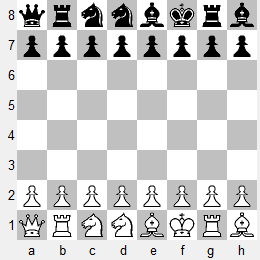In that first exercise I chose my own first move based on what I considered to be the logical requirements of the SP, and I chose my opponent's first move by determining the least favorable move on his list. My hypothetical opponent was HarryO of the Chess960 Jungle blog, who has set up a second experiment similar to the first. He started by identifying an SP with a long list of first moves, SP395 beats SP491 in the competition for the most number of viable starts, then whittled the list down by applying another level of logic, What is a logical first move?.
If the position shown in the following diagram looks familiar, it's not your imagination playing tricks. It is similar to the SP used in the first 'Choosing' exercise; the only difference is that the King and Knight are switched. Just as in traditional chess, where a small difference in two positions can make a large difference in the evaluation of those positions, similar chess960 SPs can have large differences in their logical underpinnings.
For example, in SP491 I saw 'no reason to favor one of the castling options over the other'. In the current position, the players can castle O-O without any preparation, while castling O-O-O will take four moves: one Pawn move and three minor piece moves. This means that castling O-O is more likely to occur. When you consider that the players will also need to weaken the Queenside (a-side) slightly to let the corner Queen out, castling O-O looks even more likely.
Based on the principle of making the obvious moves first, 1.O-O is a good candidate move. Unlike many chess960 players, I prefer to hold off early castling even when possible. Castling, being a mainly defensive move, is somewhat passive and thereby risks losing White's natural initiative. On top of that, there is always a possibility that castling to the other side will prove to be appropriate. Are there any other good moves?
The move I chose in the SP491 exercise, 1.d4, suggests itself again. It plants a Pawn in the center, opens a diagonal for the Bishop on e1, and prepares a shelter for the Knight on d3. It also shields the Queen from the Bishop on the long a1-h8 diagonal. Also worth considering is 1.f4, which opens the other diagonal for the Be1, prepares an open file for the castled Rook on f1, and plans to build a Pawn center with e2-e4. The move 1.c4 also looks playable, hoping to play d4 on the next move and preparing to bring the Knight to c3.
All things considered, I would play the solid 1.O-O against a higher rated player, giving me one move to see how he assesses the position. I would play the looser 1.d4 against an equal or lower rated player. Nothing dictates that the same first move is best in all circumstances.

SP395 QRNNBKRB
To choose White's first move in the game where I am playing Black, let's look at the list in HarryO's 'Logical First Move' post. He leaves a choice of eight moves, including two that I also like for White, 1.c4 and 1.d4. Of the remaining moves, the two Knight moves, 1.Nc3 and 1.Ne3, aren't something I would play, but they both prepare Nd5 with an attack on the weak c-Pawn. If this happens, Black can defend adequately with ...Ne6, leaving a large number of other moves to play first. Both Knight moves leave White with the natural initiative of the first move, so they are good moves for White.
Are there any first moves for White that don't keep the initiative? Both 1.d3 and 1.e3 look suspicious, because they are passive and put no pressure on Black. The move 1.d3 at least opens a diagonal for a Bishop, but 1.e3 does nothing to further the development of any pieces. The move 1.e3 even allows Black the same range of options as White had on the first move. I could continue and choose a first move for Black, but that goes beyond the objective of this exercise.
To summarize, either 1.d4 or 1.O-O, according to circumstances, would be my first move, and 1.e3 would be the first move for my hypothetical opponent. I get good play in both games.

No comments:
Post a Comment